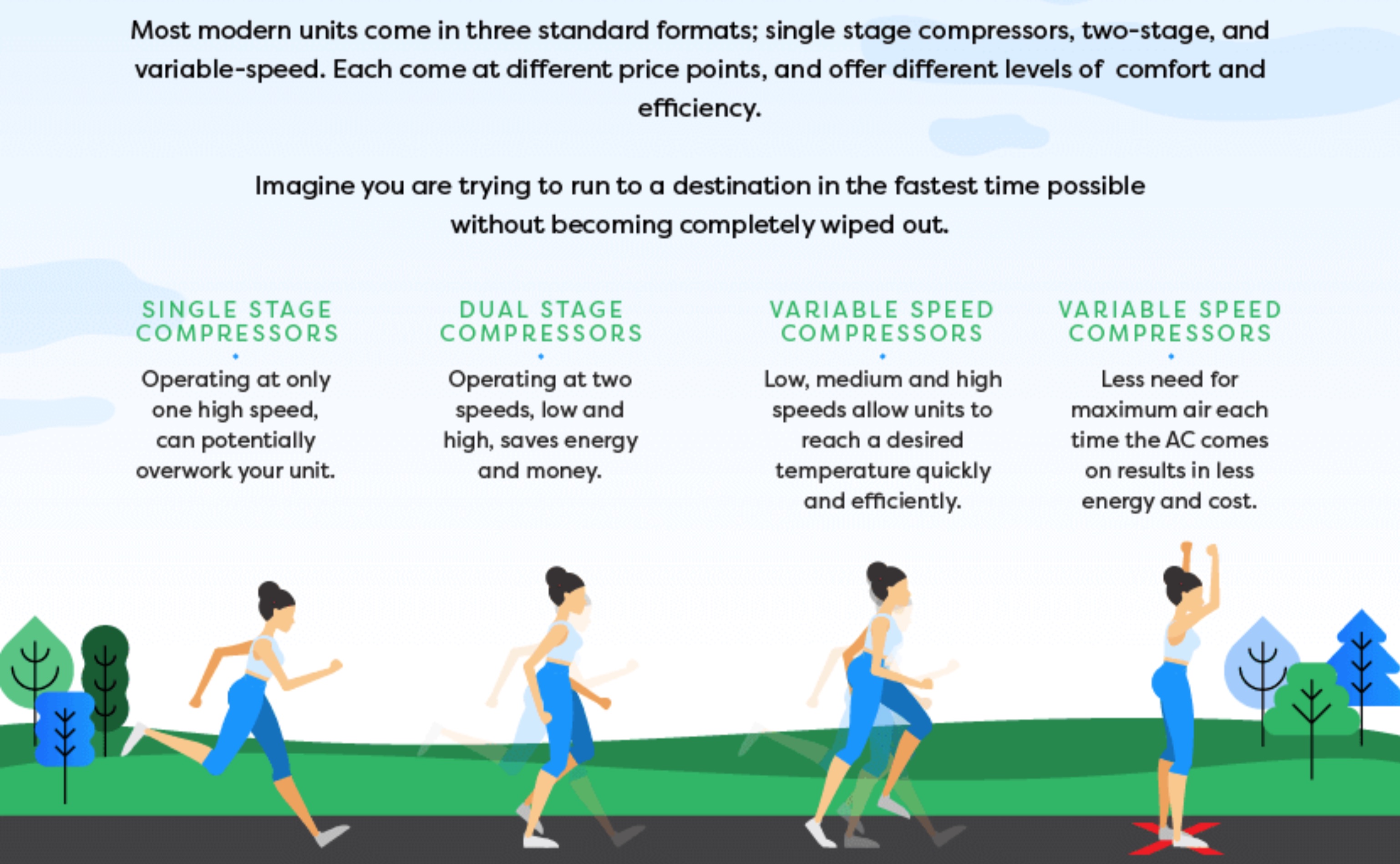What Size Air Conditioner Do I Need?
How to Determine What Size Air Conditioner You Need
What size air conditioner do I need for a 2000 square foot house? How many tons of AC do I need per square foot? If you’re asking these questions, you’re probably in the process of buying a new air conditioner or heat pump. Figuring out what size air conditioner you need is an important first step when replacing an older air conditioning system.
Do you already know how many tons your existing air conditioner is? If so, you might think it should be replaced with a new AC unit the same size. While that is true in most cases, it’s not true in all cases.
Getting this step wrong can make the difference in the performance, efficiency, and longevity of your new air conditioning system.
In the 26 years since Magic Touch Mechanical first opened in Mesa, AZ., we’ve replaced tens of thousands of units. Approximately 15-20% of those systems we replaced required either a larger or smaller air conditioner than the unit it replaced. In other words, 15-20 of every 100 units we replace were not properly sized in the first place!
While 15-20% might sound like a low percentage – imagine if your home was/is one of those 15-20 improperly sized/installed. New air conditioners cost too much money not to provide the comfort you paid hard earned money for. Comfort aside, frequent breakdowns and shorter equipment lifespan are the two main reasons you can’t afford the wrong size AC.

Using a Rule of Thumb to Determine How Many Tons of Air You Need
There is no such thing as a “good rule of thumb” to properly size an air conditioning and heating system. It’s fine to use a rule of thumb to get and give replacement quotes. This way you’ll have a close ballpark number for budgeting purposes. However, prior to installation your air conditioning contractor should verify the proper size for the application.
Magic Touch goes so far as having someone reinspect the site, verify measurements, ducting, insulation, etc. prior to installation. The adage – measure twice, cut once – applies to all home improvement projects. In 26 years, we’ve never installed the wrong size air conditioner – a record we have, thanks to performing load calculations!
Don’t Rely on the Rule of Thumb Method to Know What Size AC You Need
No HVAC experience is necessary to understand why you can’t determine AC size needed based on square footage alone. I’ve created two examples below to demonstrate why it takes more than a rule of thumb for proper AC sizing.
For these examples, let’s use, ‘1 ton of air conditioning per 400 square feet’. This is the common formula used by air conditioning contractors in the Phoenix, AZ area.
Phoenix, AZ area Rule of Thumb: 1-Ton of cooling for every 400 sq. ft.

Example 1: Two 2,000 square foot homes with identical floor plans right next to each other.
Based on the rule of thumb both homes would require a 5-ton air conditioner.
- Home 1 has: R-40 Insulation in the attic, new dual-pane low-e windows, solar shade screens on all southern, western, and eastern facing windows, has a 10’patio cover shading 50% of the south facing windows, and has two occupants.
- Home 2 has: R-19 Insulation in the attic (and the cable-guy moved a bunch of it so there’s only an inch or two in a lot of places). The home’s windows are single-pane and leaky due to bad seals. There are no shade screens (aka sunscreens or solar shade screens), only insect screens on the windows. The home has large windows which catch the afternoon sun. This home has a patio too, but sits at a different angle than next door, so patio windows aren’t shaded. This home is occupied by 6 people.
Do you think these two 2,000 s. f. homes with identical floor plans require the same size AC unit? Of course not. As you can see by this example, you can’t determine what size air conditioner you need by square footage alone.
You Must Know the Load to Determine What Size Air Conditioner is Needed
A load calculation must be completed to determine what size air conditioner you need.
The conditions of the two homes in the examples above help calculate the total ‘load’ of the home. These are just a few of the conditions that we enter a ‘load calculation’ to determine what size air conditioner is needed.
Clearly the two homes in the above example have very different loads even though they have identical floor plans. There’s a very good chance the load on these homes is 2-3 tons apart.
The “load” determines the capacity aka tonnage (air conditioner size) needed. Yes, square footage is a factor in the load – I’d go as far as saying one of the key factors. However, it’s only one of many factors that need to be added into a load calculation. A load calculation changes what size air conditioner you need from a guess to a fact.
ACCA Writes the Standards for Air Conditioner Sizing & Installation
ACCA (Air Conditioning Contractors of America) is the organization that writes the standards for proper air conditioning sizing & installation. These standards are followed by most city, state, and even federal inspectors and agencies. They include the requirement of a Manual-J Load Calculation (load calculation.) when installing or replacing a heating & cooling system.
This mathematical formula is also known as a “Heat Gain Analysis”. In the example above, Home #2 would obviously be gaining heat from outside much faster than Home #1. So, common sense would dictate house #2 needs a bigger unit (maybe even two units) to do the same job.
Technically, common sense would dictate home improvements be done to Home 2 to reduce the load. However, this article is about how to determine what size air conditioner is needed for the home’s current conditions.

Magic Touch – Proud Winner of the National Contractor of the Year Award
Example 2: Two 2,000 square foot homes with different floor plans right next to each other. Based on the rule of thumb, both homes require a 5-ton air conditioner.
- Home 1 is: A 2-story stucco covered, framed home with a bedroom over the garage. The front of the home faces north and most of the windows are on the south and west side. There are 5 occupants including three teenagers who each have a friend over most of the time. This home also has a very large doggy-door for their two Labradors.
- Home 2 is: A single-story ranch block-built home. The front of the home also faces north but most of the windows are on the north and east side. There is 1 occupant who occasionally has a guest come by for a few hours. This occupant has one indoor cat who never goes out because of those Labs next door.
Do you think these two 2,000 square foot homes with very different floor plans require the same size AC unit? On a 100-degree day, could both homeowners maintain a 75-degree set temperature indoors with the same size unit?
IF you’ve read this far you already know the answer is no, and the reasons why. I simply created this 2nd example to demonstrate it’s not about square footage, regardless of the floor plan or construction type.
Why Do HVAC Contractors Use a Rule of Thumb?
My first response is – good question! Also, load calculations are time consuming, require a lot of knowledge of buildings, construction, and building science. To produce accurate results, load calculations require a lot of training, experience, and practice.
In my 35 years in HVAC, I’ve determined Wrightsoft Corporation makes the most accurate ACCA approved, Manual-J load calculation. Wrightsoft’s software doesn’t come cheap and requires ongoing upgrades and support as building materials and practices change and progress.
We use Wrightsoft products to perform both whole-home and “room-by-room” load calculations. We also use their other software platforms to determine duct sizing (Manual-D), and equipment selection, aka Manual-S.
All this software requires ongoing training which we often must travel to attend. In other words, doing things the right way comes at a price. However, doing things the wrong way comes at a much higher price which unfortunately is paid by the homeowner. That price is paid in your family’s discomfort, high utility bills, shorter unit life, frequent equipment failures and costly repairs.
Does a Bigger Air Conditioner Cool Faster?
Bigger is not better when it comes to air conditioners despite what most people think. Just as wearing bigger shoes than you need won’t make you run faster, bigger air conditioners don’t cool faster.
In fact, quite the opposite is true. Installing a larger air conditioner than needed to handle the load can cause more discomfort than an AC that’s too small. The reason for the load calculation is to make sure you get the exact right size air conditioner. Back to the shoe analogy, the reason there’s a tool to measure your feet is to find an exact fit.

Why Would my AC Unit Size Change? The Old One Worked Great for Years.
I understand why people are apprehensive when being informed the replacement air conditioner should be smaller or bigger than the old unit. You had a 3-ton before and it worked fine, why would another 3-ton not be the right size replacement? The answer is, not every unit ‘labeled’ a 3-ton (example), is in fact a true 3-ton.
1-Ton is ‘technically’ supposed to equal 12,000 BTU’s. However, supposed to and actually do aren’t one in the same.
Unlike 1-ton of weight, which is equal to 2,000 pounds (U.S.), the phrase, “ton” in HVAC is a made-up number. A ton is a nominal number with regards to equipment sizes. Technically speaking, 1 air conditioning ton is ‘supposed’ to equal 12,000 BTUH (British Thermal Units Per Hour). However, because a ton is a nominal number in HVAC it doesn’t translate to a hard measurement.
Load calculations calculate BTUH, not tons. Air conditioner manufacturers like Trane, Carrier, Lennox, and Goodman determine what units they classify as a 3-ton. In other words, if their 3-ton is in the ‘ballpark’ – they can call it a 3-ton – even if it’s not.
EXAMPLE: 3-Ton should technically be 36,000 BTUH (12,000 BTUH = 1-Ton x 3 = 36,000 BTUH)
- Manufacturer-A may call their 32,000 BTUH unit a 3-ton.
- Manufacturer-B may call their 38,000 BTUH unit a 3-ton.
Let’s take that one step further. The load calculation determined the home needed 40k BTUH.
Given the choices above, Manufacturer B’s “3-ton” unit is the better selection. The 2k BTU difference could, and most likely would, go unnoticed by the occupants.
Manufacturer A’s “3-ton” unit is almost ¾ of 1-ton too small. That would most likely not go unnoticed and would likely struggle to keep up.
What Size Variable Speed Air Conditioner Do I Need?
Variable speed air conditioners & heat pumps also called inverter units are a game changer. Variable speed units vary the BTUH they deliver up or down as the load increases or decreases.
For example, at 4pm in July, the load is much higher than it is at 3am the following morning. Just as the load in April is going to be much lower than it is in August. Variable speed air conditioners can be the right size for the load by matching their output to the load at the time.
While you wouldn’t want to install a 5-ton variable speed system in a home that needed 2.3-tons (example) – a 3-ton variable speed unit would be fine in that application. Why, because the output would automatically adjust accordingly.

Just Choose the Right Air Conditioning Contractor
All you really need to do is choose the right contractor and you won’t have to worry about these details!
For example, near the Phoenix area if you call Magic Touch – we’re going to complete a load calculation before install. We’re covering our butts too! We haven’t had to pull out an improperly sized unit in 26 years and don’t want to start with yours.
Keep in mind contractors won’t produce a load calculation until after you’ve purchased from them. Again, there is a lot of time and expense that goes into this process. That work is their intellectual property until you purchase it from them.
For expert air conditioner replacement and ACCA approved Manual-J Load Calculation in Mesa, AZ and Phoenix suburbs, CONTACT US TODAY!


Author: Rich Morgan, CEO Magic Touch Mechanical
Magic Touch Mechanical
Email: Info@MagicTouchAir.com
URL: https://airconditioningarizona.com/